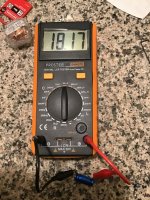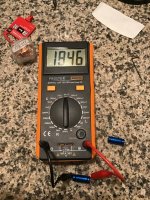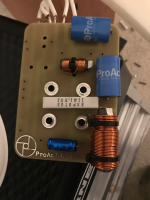as some of you know , I am creating an external xo for my Proac DT8’s
I’m the xo woofer circuit there is an ALCAP 16uf cap, and on both speakers they measure a touch over 18uf.
im confused.
the woofer circuit has only an inductor and cap. Why would Proac put a cap in there that is +-10% ?
did they know these caps measured 18uf ?
was the design originally for a 16uf cap there but they just threw in a cap that measured a bit over 18uf?
im confused because i put in a Poly cap which reads 16uf and that value sounds quite a bit different than 18uf.
its not a bad sound but just different now that the woofer I’m assuming is crossing a bit higher.
i don’t get why someone would put in a cap that says 16uf but measures a bit over 18uf.
🤷♂️
I’m the xo woofer circuit there is an ALCAP 16uf cap, and on both speakers they measure a touch over 18uf.
im confused.
the woofer circuit has only an inductor and cap. Why would Proac put a cap in there that is +-10% ?
did they know these caps measured 18uf ?
was the design originally for a 16uf cap there but they just threw in a cap that measured a bit over 18uf?
im confused because i put in a Poly cap which reads 16uf and that value sounds quite a bit different than 18uf.
its not a bad sound but just different now that the woofer I’m assuming is crossing a bit higher.
i don’t get why someone would put in a cap that says 16uf but measures a bit over 18uf.
🤷♂️
Attachments
From a dealer.
that pic you have isn’t the same speaker.
the electrolytic on mine says +-10%. So it’s a bit more
but I still don’t get why such a bit difference which is clearly audible.
thanks
that pic you have isn’t the same speaker.
the electrolytic on mine says +-10%. So it’s a bit more
but I still don’t get why such a bit difference which is clearly audible.
thanks
The capacitance at zero bias could be different from that measured at a particular voltage.
ok but how much voltage is that cap seeing in that circuit and in a xo?
thanks
ok but how much voltage is that cap seeing in that circuit and in a xo?
In a crossover, exactly zero volts.
Film capacitors have no significant such behavior at any voltage within ratings.
Then, it’s just a question of parts quality used for this loudspeaker model. Depending on price, manufacturer could not care for tight parts tolerances and small reproduction differences among loudspeakers. It’s your pick which capacitor and corresponding reproduction you prefer. At least, measure and ensure that both boxes have close capacitor values.From a dealer.
that pic you have isn’t the same speaker.
the electrolytic on mine says +-10%. So it’s a bit more
but I still don’t get why such a bit difference which is clearly audible.
thanks
Then, it’s just a question of parts quality used for this loudspeaker model. Depending on price, manufacturer could not care for tight parts tolerances and small reproduction differences among loudspeakers. It’s your pick which capacitor and corresponding reproduction you prefer. At least, measure and ensure that both boxes have close capacitor values.
yeah man. It just baffles me. Lol. pun intended.
i mean the difference between 16uf and 18uf in that circuit isn’t small. It’s not night and day either. But it’s definitely noticeable.
the 18uf crosses the woofer A bit lower and the highs are more accented.
16uf makes the sound a bit thicker but not as bright.
i think the woofer crossing over a bit higher makes the sound a bit thicker because the woofer doesn’t move as fast as the tweeter?
Seriously, it’s the other way around. KEF for one (at least used to) pick the exact value they need by measuring the cap, disregarding the value printed upon. An approach pretty normal when buying large quantities of certain parts. On the other hand: both your C-meter and the one at ProAc labs have each only to be 6-7 percent off, while the real value is about 17uF. Or your meter is really off. Compare it with another that also resolves the ESR.
Seriously, it’s the other way around. KEF for one (at least used to) pick the exact value they need by measuring the cap, disregarding the value printed upon. An approach pretty normal when buying large quantities of certain parts. On the other hand: both your C-meter and the one at ProAc labs have each only to be 6-7 percent off, while the real value is about 17uF. Or your meter is really off. Compare it with another that also resolves the ESR.
everything else I measured with the meter is spot on.
but you know I actually thought of that as well.
maybe Proac sifts through the parts and needed 18uf and found that value in a 16uf cap.
maybe if someone looks at another speaker like mine (DT8) it would have an 18uf cap in there.
i do find it odd that both caps say 16uf however. That is from both speakers.
maybe that run from ALCAP was wonky
I suppose Alcap does the same. Produce a lot of caps, sell them within specs (20%) on a value the customer asked for. That way you only have to change the print on the label, not the production run.
I suppose Alcap does the same. Produce a lot of caps, sell them within specs (20%) on a value the customer asked for. That way you only have to change the print on the label, not the production run.
ok but in that case those caps should have been labeled 18uf.
and that specific cap says +-10%.
don’t know man.
im confused as to which value they intended to have there.
guess I’ll just choose which one sounds best to me.
tell me if this is a ’ correct’ assumption on my part.
the sound changed and is a bit thicker in that register. I think it’s because the woofer is crossed a bit higher at 16uf instead of 18uf.
i think that instead of putting a 18uf value there, I’ll try 17uf and at the same time I’ll change the tweeter value as well from 8uf to 9uf so the tweeter crosses a bit higher as well. So the woofer xo circuit isn’t just ‘ covering all the distance‘.
i mean only my ears will tell the difference. But I’m assuming that the woofer crossed higher is making the sound a bit thicker because a woofer is slower than a tweeter?
thanks.
ok but how much voltage is that cap seeing in that circuit and in a xo?
There's no voltage across it now but there could have been some while it was being measured during testing and labelling. Also, the capacitor you mention (ALCAP) doesn't look like a film capacitor.In a crossover, exactly zero volts.
Film capacitors have no significant such behavior at any voltage within ratings.
tone? has changed two variables at once - an 18 uF electrolytic for a 16 uF film.
He's a musician, not a scientist!
He's a musician, not a scientist!
Also, the capacitor you mention (ALCAP) doesn't look like a film capacitor.
The original cap (measuring 18 uF) is an Alcap electrolytic.
tone? has changed two variables at once - an 18 uF electrolytic for a 16 uF film.
He's a musician, not a scientist!
Lots of musicians delve into the technical side, to some extent.
A local, highly accomplished pianist has built a unique, complex piano system.
https://badgerherald.com/news/2016/...-finds-keys-to-success-through-new-invention/
Also, you can't change just one section of the crossover and expect the drivers
to still properly combine (if they did so in the first place). Everything interacts.
Last edited:
The increased capacitance on the woofer(s), without changing the coil, increases the crossover frequency slightly, and also makes the crossover steeper. The frequency response will have a slight bump up below the on axis acoustic crossover point, and a slight droop down above.ok but in that case those caps should have been labeled 18uf.
i think that instead of putting a 18uf value there, I’ll try 17uf and at the same time I’ll change the tweeter value as well from 8uf to 9uf so the tweeter crosses a bit higher as well. So the woofer xo circuit isn’t just ‘ covering all the distance‘.
i mean only my ears will tell the difference. But I’m assuming that the woofer crossed higher is making the sound a bit thicker because a woofer is slower than a tweeter?
Lower frequencies are "slower", but the woofer's speed hasn't changed 😉
The change also affects vertical polar pattern, peaks and nulls will be directed at slightly different angles.
Using this calculator, which allows substitution of individual part values:
https://speakerwizard.co.uk/1st-and-2nd-order-crossover-calculator-and-response-simulator/
And with no idea of the your speakers actual crossover point or type (BW or LR), ran a few examples.
Though the examples assume fixed impedance and inductance for the drivers through the crossover region, (usually not valid), they do indicate little change from a 16 (design goal) to an 18.46uF woofer capacitor value.
Doubling the value to 32uF makes the slight difference in what you are hearing more apparent.
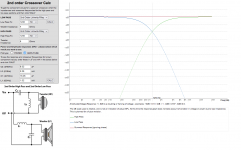
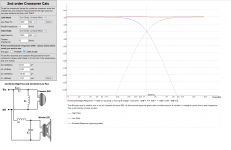
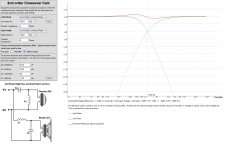
Anyway, interesting to see what the "wrong" values might do.
Art
It's reasonable to assume they wanted 16im confused as to which value they intended to have there.
That's not to say that either is necessarily perfect. If unsure, go with 16 and make your adjustments outside the crossover.
I actually like 18uf more.
16uf does sound a bit thicker around the xo point. But I’m assuming that is due to the woofer crossing over a bit higher.
im gonna try and jump the caps from the woofer and tweeter.
so make the woofer cap 17uf from 16uf and the tweeter cap 9uf from 8uf which it currently is.
also going to try and jump the 16uf woofer cap to make it 18uf as the electrolytics measure.
16uf does sound a bit thicker around the xo point. But I’m assuming that is due to the woofer crossing over a bit higher.
im gonna try and jump the caps from the woofer and tweeter.
so make the woofer cap 17uf from 16uf and the tweeter cap 9uf from 8uf which it currently is.
also going to try and jump the 16uf woofer cap to make it 18uf as the electrolytics measure.
- Home
- Loudspeakers
- Multi-Way
- Why would a manufacturer use a 16uf cap that is really 18uf?
